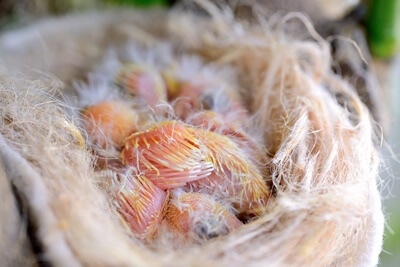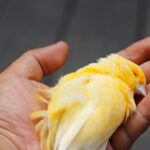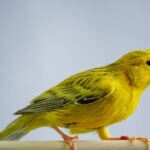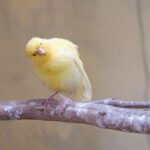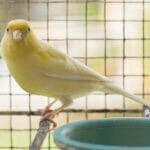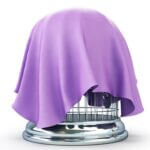Due to their fast metabolisms, birds like canaries are uniquely vulnerable domestic pets. Complications in their health and well-being can progress quickly and lead to abrupt deaths.
As with many birds, canaries produce multiple chicks in a breeding season (up to 15), which is partly a natural defense against chick mortality.
So, if you intend to breed your canaries (or you have unexpectedly discovered fertile eggs in the cage), be aware that some chicks won’t make it.
A mortality rate of around 5% is fairly normal. Nonetheless, certain factors increase the chance of your canary chicks dying in the shell before they hatch or shortly after hatching.
Do Canaries Eat Their Babies?
Larger raptors and birds eat their babies when under stress or threat. However, smaller birds (like canaries) rarely ever do this.
A breeding pair of canaries may kill a chick and push it from the nest. This happens if it is sick or presents a danger to the nest as a whole. Though it’s upsetting to witness, it’s a natural behavior that indicates the chick was already dead or dying.
There’s a chance of underlying issues threatening the other chicks or the breeding pair. The factors that influence domestic chick mortality include:
- Environmental imbalances
- Health complications
- Food supply limitation or scarcity
- Lack of proper nutrient mixes
A dead hatchling in the nest may seem to ‘disappear’ after a time, especially in the wild. This has led to the common misconception that all birds eat their dead hatchlings.
The dead chick was likely ejected or trampled by siblings and parents.
Of course, if a hatchling dies in your canary’s cage, it’s better to remove the body, assuming it’s safe to do so and you won’t disturb the incubated eggs or recently-hatched chicks.
Removing dead hatchlings from the cage will also allow you to inspect the bodies for signs of sickness or injury.
Why Are My Canaries Dying?
If you’re concerned about rampant chick mortality, start by considering whether the chicks are dying in their shells or after successfully hatching. The main causes of death in chicks will depend on the stage at which the death occurs.
Nonetheless, chicks are most vulnerable during the hatching process. At this stage, you should be the most vigilant.
Why Canary Chicks Die In-Shell
Canary chicks can die early or late in incubation for many reasons. However, dying in the shell means a large issue is at play.
Here are the common reasons for chick mortality while they are still in the shell:
1/ Poor Nest Design
The wrong nesting material or nest placement can contribute to in-shell chick death. For example, the wrong nesting material will cause eggs to overheat or become chilled.
Likewise, a flimsy nest box or structure could tip or break and cause eggs to be ejected and crack. This, of course, will lead to in-shell mortality.
When choosing a nest box and material for your canaries, opt for reputable, veterinary–recommended brands, as this will protect your birds and their eggs.
2/ Yolk Sac Infection (YSI)
According to the Iranian Journal of Veterinary Research, yolk sac infection (YSI) is a concern for indoor canaries and reports high mortality rates. In most cases, this will prevent the chicks from developing and hatching.
Eggs affected by YSI may seem to develop well initially but often result in the chicks dying during incubation. In some cases, this can also result in unexpected death in 1- to 3-day-old canary chicks.
3/ Poor Incubation
Fertile eggs are susceptible to changes in temperature, so a chicken egg can die within 20 minutes if it is improperly incubated. For small birds like canaries, this window is much smaller.
Young, inexperienced canaries may incubate poorly. That said, if older and more experienced breeding pairs are doing so, it’s likely an issue with the nest or their health.
4/ Dehydration
Too much heat or too little humidity can impact hatching chicks adversely. It can make the shell membrane hard and dry as they’re hatching.
This results in the chicks becoming stuck and, over time, exhausted and dehydrating themselves. They’re often referred to as ‘sticky chicks’ and can sometimes be saved if given small amounts of water.
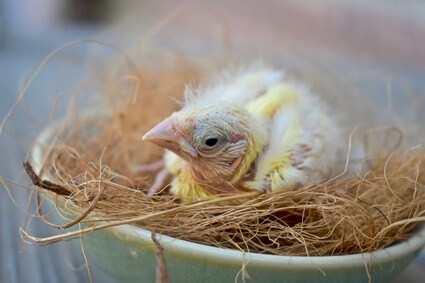
Why Canary Chicks Die After Hatching
If your canary chicks hatch successfully, the most likely causes of mortality change. While environmental factors remain important, nutrition and competition are crucial for hatchlings and fledglings:
5/ Improper Temperature
Canaries are susceptible to high and low temperatures. Beware if your canary’s cage is in direct sunlight and regularly overheats, or it gets a draft and the temperature drops low frequently. In these conditions, hatchlings are at an increased risk of sickness and mortality.
The ideal temperature range for your canary’s habitat is between 65-80 degrees Fahrenheit. If it strays from this range significantly or for extended periods of time, your canaries and their chicks will be at risk.
6/ Lack of Ventilation
A lack of proper ventilation can be dangerous for chicks before, after, and during hatching.
This, of course, ties into temperature control and ensuring ample airflow to give the chicks what they need. Ventilation can be impacted by:
- Cage design and placement
- Nest design
- The number of chicks in the nest
- Nesting materials
7/ Starvation or Malnutrition
If you have a canary caring for multiple hatchlings or fledglings, it’ll need more high-nutrient food. As your canary hatchlings age, it can be helpful to provide ‘nestling’ food to prevent malnutrition and reduce the risk of chick mortality.
This is helpful if your canary attempts to feed all the chicks but finds it difficult. If the parent canary seems to be ignoring a certain chick, it may be that this chick is sick and it’s identified as unlikely to survive. If one hatchling is being overlooked, consult a vet for advice.
8/ Genetic Defects or Disorders
Just as certain genetic conditions and congenital defects can impact children, baby canaries can also develop with defects and disorders.
In these cases, the egg is rendered unviable, the chicks pass away during hatching, or the chick dies a few days after hatching. Congenital defects in canary chicks won’t be detectable without skilled analysis.
9/ Disease or infection
Hatchlings and nestlings are especially prone to bacterial and viral infections.
If they develop an infection that’s contagious or threatens the nest, their parents may eject or kill them. Even if the parent canaries don’t, the chance of a sick canary chick dying is high.
10/ Overcrowding
Overcrowding can lead to eggs or hatchlings being displaced.
Older hatchlings or new fledglings may survive being displaced, but young hatchlings could die as a result. Eggs will, of course, not survive being ejected from the nest.
If a single chick from a clutch of eggs dies, this may be happenstance. However, if more than 10% of a canary’s chicks die, there’s a different underlying issue.
What Should I Do If a Baby Canary Fell Out of the Nest?
There are times when it’s normal for canary chicks to leave the nest, especially when they become fledglings. Even if the chick has fallen for other reasons, it has a good chance of being OK in the long run.
Just be sure the bottom of the cage is clean and well-ventilated. Likewise, the room should be warm enough, so the displaced chick doesn’t freeze.
Canaries will continue to care for healthy chicks and feed them, even if they’re out of the nest. However, if the chick manifests signs of illness, seek veterinary help.
A sick chick may have been pushed from the nest to protect its siblings. If so, your canaries won’t feed it. In fact, they may kill it if they feel it remains a threat to the well-being of other chicks.
If the chick is already dead, your next action should be based on the health and age of the canary chicks in the cage.
If the dead canary is still in the nest and there are unhatched eggs or very young hatchlings, you shouldn’t remove it. Disturbing eggs or young chicks could be disastrous.
If the dead chick is on the cage floor, you could remove it carefully.

